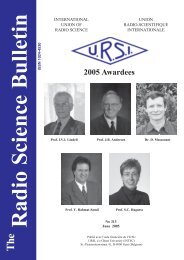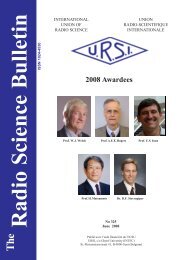mimo channel capacity: electromagnetic wave perspective - URSI
mimo channel capacity: electromagnetic wave perspective - URSI
mimo channel capacity: electromagnetic wave perspective - URSI
Create successful ePaper yourself
Turn your PDF publications into a flip-book with our unique Google optimized e-Paper software.
decrease. Hence, there is an optimal number of antennas, for which the <strong>capacity</strong> is maximum. An argument like this onehas already been presented earlier [5]. However, the optimal number of antennas has not been evaluated. To accomplishthis, we use the MIMO <strong>channel</strong> model presented in [7]. Strictly speaking, the model in [7] is a two-dimensional one.However, it can be applied to both orthogonal planes and, due to the symmetry of the problem (no preferred direction),the same result should hold in 3D as well. We note that, under the assumptions above, the angle-of-arrival (AOA) of0,2π in both planes. Thus, the model above can be applied andmultipath components is uniformly distributed over [ ]the minimum distance is half a <strong>wave</strong>length. Due to the assumption of uniform scattering media, all the antennasexperience the same multipath environment. Using the argument and the minimum distance above, we easily estimatethe maximum number of antennas (“sphere packing”) and, hence, the maximum MIMO <strong>capacity</strong> of a given region ofspace:n6V288V⎛ ρ ⎞opt ≈ = and CV 3 max ≈ noptlog21+S πλ ⎜ n ⎟⎝ opt ⎠where V is the volume of the space region considered, and λ is the <strong>wave</strong>length, and factor 6 is due to 6 polarizationaldegrees of freedom. The last equality holds due to the rich scattering assumption (i.e., the <strong>channel</strong> is uncorrelated).Some conclusions from this analysis are as follows. The maximum <strong>capacity</strong> depends on the size of the spaceregion considered as well as on the <strong>wave</strong>length. Thus, a spatial <strong>capacity</strong> can be defined as the maximum <strong>capacity</strong> of aunit space region (bits/s/Hz/m 3 ), similar to the conventional <strong>capacity</strong> of a unit bandwidth (bits/s/Hz). Hence, space canbe considered as a <strong>capacity</strong>-bearing object, similar to the bandwidth. The time (or frequency) domain and the spacedomain are included in this notion of <strong>capacity</strong> on an equal basis, which is in good agreement with the basic physicalconcepts (i.e., the special relativity). While the traditional approach allows us to define the <strong>capacity</strong> of a unit bandwidth(i.e., 1 Hz), the new limit defines the <strong>capacity</strong> of a unit space region (i.e., 1 m 3 ). We believe this partially answers thesecond question stated at the beginning. Our final remark is that while the limit above may be far away from anypractically-achievable bit rate in a foreseeable future, it does provide some insight in the relation between the laws ofelectromagnetism and the laws of information theory.ACKNOWLEDGEMENTSThe author wishes to thank Dr. C. Charalambous for many fruitful discussions.(8)References[1] D.S. Shiu, G.J. Foschini, M.J. Gans, J.M. Kahn, Fading Correlation and Its Effect on the Capacity of MultielementAntenna Systems, IEEE Trans. on Communications, v. 48, N. 3, Mar. 2000, pp. 502-513.[2] A. M. Sengupta, P. P. Mitra, “Capacity of multivariate <strong>channel</strong>s with multiplicative noise: I. Random matrixtechniques and large-N expansions for full transfer matrices,” Bell Labs., Tech. Rep., 2001.[3] S.L. Loyka, Channel Capacity of Two-Antenna BLAST Architecture, Electronics Letters, vol. 35, No. 17, 19thAug. 1999, pp. 1421-1422.[4] S.L. Loyka, J.R. Mosig, Channel Capacity of N-Antenna BLAST Architecture, Electronics Letters, vol. 36, No.7,pp. 660-661, Mar. 2000.[5] S.L. Loyka, J.R. Mosig, Spatial Channel Properties and Spectral Efficiency of BLAST Architecture, AP2000Millennium Conference on Antennas & Propagation, Davos, Switzerland, 9-14 April, 2000.[6] S.L. Loyka, Channel Capacity of MIMO Architecture Using the Exponential Correlation Matrix, IEEECommunication Letters, v.5, N. 9, pp. 369 –371, Sep 2001.[7] S. Loyka, G. Tsoulos, Estimating MIMO System Performance Using the Correlation Matrix Approach, IEEECommunication Letters, v. 6, N. 1, pp. 19-21, Jan. 2002.[8] S. Loyka, A. Kouki, New Compound Upper Bound on MIMO Channel Capacity, IEEE Communications Letters, v.6, N. 3, pp. 96-98, Mar. 2002.[9] A. L. Moustakas et al, Communication Through a Diffusive Medium: Coherence and Capacity, Science, v. 287, pp.287-290, Jan. 2000.[10] M.R. Andrews, P.P. Mitra, R. deCarvalho, Tripling the Capacity of Wireless Communications UsingElectromagnetic Polarization, Nature, v.409, pp. 316-318, 18 Jan. 2001.[11] G.J. Foschini, M.J Gans: ‘On Limits of Wireless Communications in a Fading Environment when Using MultipleAntennas’, Wireless Personal Communications, vol. 6, No. 3, pp. 311-335, March 1998.
















